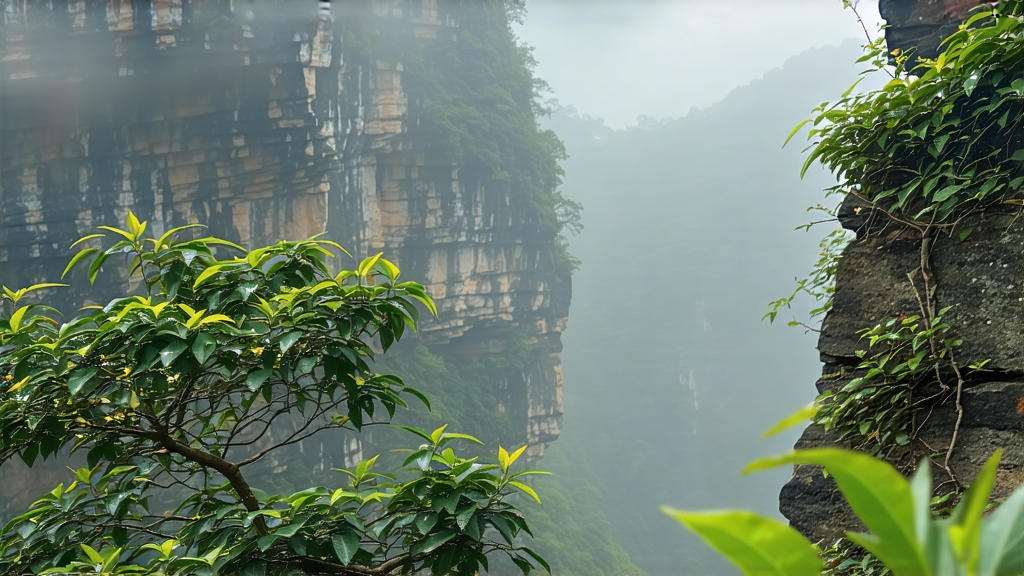
When Chinese tea lovers speak of “the seven necessities of daily life,” they list firewood, rice, oil, salt, soy sauce, vinegar—and tea. Among the hundreds of teas that might fill that last slot, none carries more imperial romance than Da Hong Pao, literally “Big Red Robe,” the flagship of Wuyi rock oolongs. Grown on the vertiginous cliffs of northern Fujian’s Wuyi Mountains, this tea is celebrated for its “rock rhyme” (yanyun), a mineral depth that connoisseurs compare to licking wet slate in a pine forest. To understand Da Hong Pao is to step into a landscape where myth, geology, and craftsmanship converge in every curled leaf.
Legend dates the tea to the Ming dynasty (1368-1644). A traveling scholar, en route to the capital for imperial exams, fell ill near the Wuyi cliffs. Monks from a local temple brewed leaves picked from nearby bushes; the scholar revived, passed the exams, and returned in triumph. To express gratitude, he draped his crimson imperial robe over the tea bushes, proclaiming, “Your leaves cured me; may your fame be cloaked in red.” Whether apocryphal or not, the story cemented Da Hong Pao’s reputation as tea fit for emperors. By the Qing era, tribute quantities were so coveted that armed guards allegedly protected the six original mother trees clinging to Tianxin Rock.
Geologically, the Wuyi range is a UNESCO World Heritage Site where volcanic tuff has weathered into a shallow, mineral-rich soil. Tea gardens—more accurately, cliff-side terraces—sit 300–600 m above sea level, perpetually wrapped in fog that refracts light and slows photosynthesis. These stressful conditions force the tea plant (Camellia sinensis var. sinensis) to channel nutrients into fewer leaves, concentrating polyphenols, amino acids, and aromatic oils. The result is a leaf that carries the literal taste of stone, a terroir impossible to replicate even in neighboring valleys.
Modern Da Hong Pao falls into three categories. “Mother Tree” tea, harvested until 2006 when the government halted plucking to protect the 350-year-old bushes, now exists only in private collections; a single gram once sold for USD 1.2 million at auction. “Purebred” or “Qidan” comes from cuttings of those originals, vegetatively propagated and cultivated in similarly rocky microclimates. Finally, “blended” or “commodity” Da Hong Pao accounts for 95 % of the market, marrying leaves from Wuyi’s many rock-oolong cultivars—Rougui, Shui Xian, Tie Luo Han, Bai Ji Guan—to approximate the mother tree profile. A master blender tastes through hundreds of lots, aiming for a balance of floral top notes, roasted honey mid-palate, and the tell-tale mineral finish that lingers like struck flint.
Crafting Da Hong Pao is a month-long choreography of stress and rest. Picking occurs in late April when leaves are 60 % open, the standard “zhong kai mian” (medium opening). Only the top three or four leaves are taken, because older leaves contain the lignin that will later translate into layered aroma. After a brief outdoor withering under soft morning sun, the leaves are moved indoors onto bamboo trays for 6–8 hours of shaking and tumbling. This bruises the edges, initiating oxidation while the center stays green—oolong’s defining “green heart with red edge.” Once the leaf emits a ringing bell-like scent, it is pan-fired at 230 °C for 3–5 minutes to arrest oxidation at roughly 40 %. Rolling follows, twisting the leaf into the trademark “dragonfly head, frog leg” shape that traps aromatic compounds. Then comes the most Wuyi-specific step: charcoal roasting.
Roasting is where science meets ancestor worship. Using local hardwoods—litchi, longan, or pine—tea masters maintain a low, steady ember bed for 8–12 hours at 80–120 °C. The tea rests for a month, then is roasted again; premium lots may cycle through three to five roasts across half a year. During each round, amino acids and sugars undergo Maillard reactions, generating roasted almond, cacao, and pipe-tobacco notes while sublimating grassy volatiles. The master judges readiness by sound: when a handful of leaves rustles like dry autumn leaves, the batch is done. Over-roast and you bury the